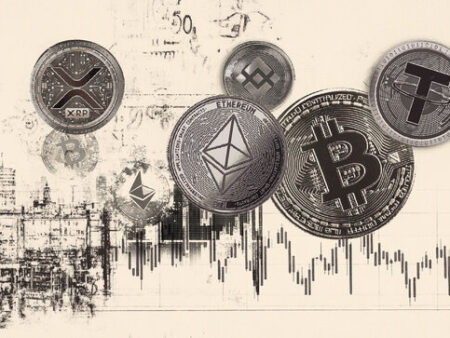Cryptocurrency Market Consolidates Losses Amid Global Economic Tensions
The cryptocurrency market is currently consolidating losses after a volatile start to the week. Bitcoin (BTC) attempted to stabilize above $106,000 but lost momentum, resulting in a pullback to $105,204 as of Tuesday. Ethereum (ETH) presents a more stable technical structure compared to Bitcoin, supported by consistent inflows into spot ETFs.
Economic Uncertainty Weighs on Bitcoin
Uncertainty in the global macroeconomic environment, particularly tariff tensions, is unsettling investors and increasing selling pressure on cryptocurrencies. Bitcoin spot ETFs experienced their third consecutive day of outflows on Monday, breaking a 10-day streak of inflows.
Market Overview: Profit-Taking and Global Trade Uncertainty Impact Crypto Prices
Bitcoin’s reversal from its all-time high of around $111,980 has created uncertainty in the cryptocurrency market, hindering the anticipated altcoin season. Trade tensions related to U.S. tariff uncertainty have made investors nervous, leading to profit-taking and impeding price recovery.
However, Crypto Finance suggests that this correction is a healthy part of price discovery.
“This price behavior is completely logical—we are in a new phase of price discovery, and it is natural to see both profit-taking and hesitation to follow the uptrend despite favorable headlines,” said Crypto Finance in Tuesday’s market outlook. “This dynamic is visible in both spot and derivatives markets.”
Ethereum Shows Strength
Ethereum (ETH) presents a more stable technical structure compared to Bitcoin, supported by consistent inflows into spot ETFs. CoinShares’ weekly digital asset report highlighted Ethereum’s leading inflows, marking its strongest streak since 2024.
“Ethereum surges, Bitcoin stalls: Ethereum led with $321 million in inflows—its best 6-week run since December 2024—while Bitcoin saw a mid-week reversal, ending with $8 million in outflows,” states the CoinShares report.
Key Data: Bitcoin ETF Outflows Increase
Bitcoin spot ETFs saw approximately $268 million in net outflow volume on Monday, marking the third consecutive day of outflows. Prior to this, Bitcoin spot ETFs had maintained a 10-day net inflow trend. With the exception of Bitwise’s BITB ETF, all other ETF products authorized to operate in the U.S. recorded net outflows or zero flows on Monday.
Ethereum ETFs Maintain Inflow Trend
Ethereum spot ETFs continue to see inflows, recording over $78 million in net inflows on Monday. The 11-day net inflow trend has pushed the total cumulative net inflows to $3.12 billion. Interest in Ethereum has been increasing since the Pectra upgrade in May, improving sentiment and maintaining the price around the $2,600 support level.
“Ethereum led the pack this week, with another week of inflows totaling $321 million, bringing this 6-week consecutive run of inflows to $1.19 billion, its best run since December 2024, marking a decisive improvement in sentiment,” highlights the CoinShares weekly digital asset flows report.
Bitcoin Faces Downside Risks
Bitcoin’s price is around $105,204, slightly down for the day. The overall outlook remains bearish, supported by the Moving Average Convergence/Divergence (MACD) indicator, which has maintained a sell signal since May 25. This signal occurs when the blue MACD line crosses below the red signal line, making short positions attractive to traders. Expanding red histogram bars below the zero line (0.00) on the daily chart suggest that sellers have the advantage, at least for now.
Beyond immediate support at the $105,000 level, traders may want to pay attention to the area around $103,100, which was tested on Saturday. Other key levels to monitor for potential support include the 50-day Exponential Moving Average (EMA) at $100,633, the 100-day EMA at $96,366, and the 200-day EMA at $91,106.
Ethereum Consolidates Above Support
Ethereum is consolidating above the crucial support level at $2,600, currently trading at $2,617. The 200-day EMA reinforces support in the short-term range at $2,459, which, if respected in the coming sessions, could increase the likelihood of a breakout towards the $3,000 target.
The 50-day EMA recently crossed above the 100-day EMA, validating a golden cross. This bullish outlook, along with consistent inflows into Ethereum-based products, suggests strong upward momentum. However, the downward-sloping MACD indicator, signaling a sell, calls for caution among traders this week.
Cryptocurrency Metrics FAQs
- What determines the total number of tokens for a cryptocurrency?
The developer or creator of each cryptocurrency decides the total number of tokens that can be minted or issued. Only a certain number of these assets can be minted through mining, staking, or other mechanisms. This is defined by the algorithm of the underlying blockchain technology. Since its creation, a total of 19,445,656 BTC have been minted, which is the circulating supply of Bitcoin. On the other hand, the circulating supply can also decrease through actions such as token burning or mistakenly sending assets to addresses of other incompatible blockchains.
- How is market capitalization calculated?
Market capitalization is the result of multiplying the circulating supply of a specific asset by its current market value. In the case of Bitcoin, the market capitalization in early August 2023 exceeds $570 billion, which is the result of the more than 19 million BTC in circulation multiplied by the price of Bitcoin, which is around $29,600.
- What does trading volume represent?
Trading volume refers to the total number of tokens of a specific asset that have been traded or exchanged between buyers and sellers within a set trading schedule, for example, 24 hours. Used to measure market sentiment, this metric combines all volumes from centralized and decentralized exchanges. Increased trading volume often denotes demand for a particular asset, as more people are buying and selling the cryptocurrency.
- What is the funding rate?
The funding rate is a concept designed to encourage traders to take positions and ensure that the prices of perpetual contracts match those of spot markets. It defines a mechanism for exchanges to ensure that future prices and periodic price payments converge regularly. When the funding rate is positive, the price of the perpetual contract is higher than the market price. This means that traders who are bullish and have opened long positions pay traders who are in short positions. Conversely, a negative funding rate means that the prices of perpetual contracts are lower than the reference price, so traders with short positions pay traders who have opened long positions.
Stay ahead of the curve in the fast-paced crypto world – explore the latest updates and trends at Cryptonewsfeeds.com.










